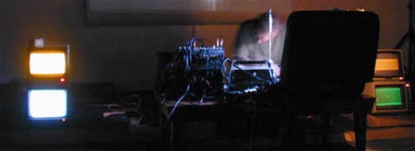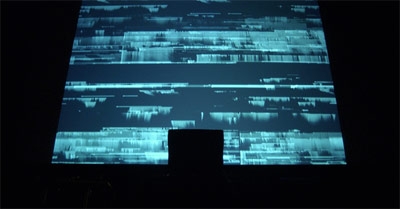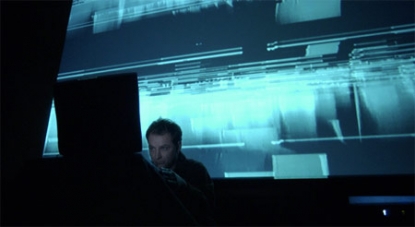Feature: Conversations
The Sound of Scott Arford
Scott Arford is a Bay Area artist whose work includes numerous performances, installations, video screenings, and audio recordings that explore the physical and aesthetic relationship between sound, space, and vision. He has performed his solo audio-video work Static Room, as well as a spatial acoustic concert created with fellow sound artist Randy Yau,Infrasound, at the San Francisco Museum of Modern Art. Arford worked as a sound designer for Brian Conley’s WAR project featured in the BitStreams exhibition at the Whitney Museum of Art, and has collaborated on several international projects, including an installation with Squid Soup at the Institute for Contemporary Art in London and an installation with the Bureau of Low Technology at the Salon Festival in Zagreb, Croatia. Arford has also been integral to the development of the Bay Area media arts scene since his arrival over ten years ago. In 1996 he founded 7hz, a warehouse/performance space dedicated to live experimental media, hosting internationally recognized artists such as Scot Jenerik, Kit Clayton, Francisco Lopez, and John Duncan.
Kathleen Maloney: What kind of work have you done in terms of experimenting with the materiality of sound? Is there an aesthetic aspect to these investigations?
Scott Arford: I have a project with Randy Yau called Infrasound. That sound has nothing to do with beauty. I don’t care how it sounds.
KM: Why?
SA: The project is about the physicality of sound, the physical experience of sound, and the translation of sound into physical force. The device is essentially a P.A. system with big subwoofers and tone generators (sine waves). We use frequencies from 20 Hz to 100 Hz and generate sine tones that are slightly detuned — we will maybe play a 30 Hz tone and 30.1 Hz tone — to create beating patterns. The sound of the beating pattern is similar to the waving and shimmering sounds you hear when strumming notes on a guitar that are out of tune. Essentially, this slightly out-of-tune beating pattern creates a frequency at the beating pattern itself. We’ll get a wave of pressure occurring at the function of the beating pattern, so we can create lower frequency beating patterns (or infrasound – a frequency too low to be detected by the human ear) with higher frequency tones. The project is really about activating the space and the audience in a very physical way. When we get complex sounds going, complex in terms of say a 30 Hz tone, a 40 Hz tone, and 60 Hz tone all at the same time, you get this incredibly interesting and amazing interaction of waves. Since every space has its own resonance, certain frequencies will be amplified and certain frequencies will be attenuated. Things in the room will often shake a little bit or people may actually feel a lower frequency, like a 7 Hz beating pattern, which can physically affect the body.
KM: Where you position yourself in the space also probably alters your experience.
SA: It is good to move around during the show. There are resonant spots, nodes, places where the sound cancels, and a lot of other different kinds of things happening. The first concert was at 7hz. At the end, the sound level was so intense that Randy and I could barely breathe or see straight. It was bizarre; we were standing between two speakers and it was like the air was pushing on our chests. My computer screen looked like it was rolling. It was completely nuts.
Also, the reaction to that project is of great interest because it so physical. People often say, “Thanks for the massage,“or something along those lines. After a show at Aaron Ximm’s Quiet American Space (San Francisco), this guy walks up to me, grabs my hand and says, “Man thanks, that was great.” He didn’t let go of my hand and said again, “That was really, really good, you don’t understand. When I came in here I couldn’t walk, my knee hurt so badly my friends had to carry me upstairs. I feel fine now. You healed my knee.” His friends were even there to confirm his experience.
KM: That is unbelievable. Perhaps you could go into business?
SA: [Laughter] I am really glad sound can have that effect. Even though we use a similar set of frequencies in each space, every show is totally different because the space affects how the sound works. Although I do think the Infrasound performances sound good, that doesn’t drive what we are doing.
KM: So how do you approach sound experimentation in your work when you do have a particular aesthetic in mind?
SA: For the last several years, I have been working on this Static Room project. It is a video piece where the imagery is made from static that has been incredibly manipulated and refined. The sound is generated by the video — literally. If you were to take the video output from your VCR and plug it into a speaker, the sound you would hear is the sound in the piece. But it is not just a random selection of images. I work on the images until they “sound” good. If it doesn’t sound good, I don’t care how good it looks. For the most part, I don’t really manipulate the sound or put effects on it, though I do try and make it more interesting and bring things out with a bit of equalization. What you see is what you hear is what you get.



